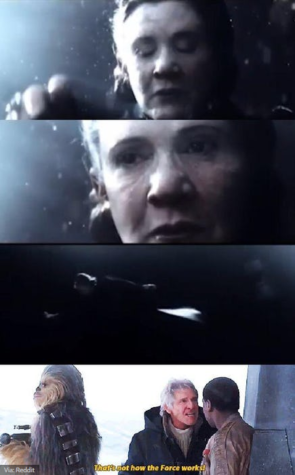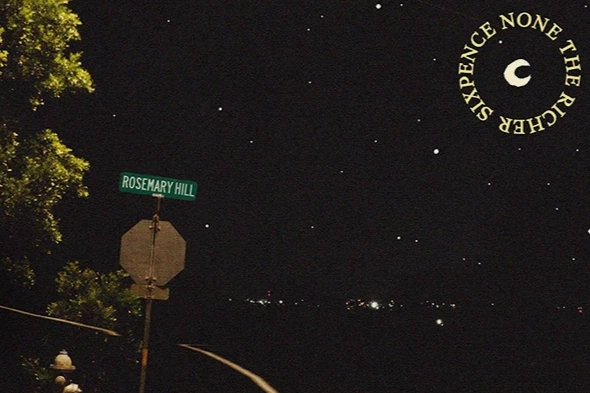
The second installment of the third trilogy and ninth full-length film release of the little-known sci-fi fantasy series called Star Wars hit theatres on Dec. 14. “Star Wars: The Last Jedi” is the longest film of the franchise with a running time of 150 minutes, and for the most part, it was a good film that made sense within the series. There is wonderful acting and engaging cinematography, however, there are moments within the film in which the plot choices in the writing become so unbelievable that they disrupt the flow of the movie and detract from its overall quality.
Episode VII: The Force Awakens left us with a fragmented group of protagonists, and because of that, Last Jedi was set up to be a series of subplots building from previous movies that were sewn together by hyperspace travel transitions. Normally, rapidly jumping between plots and characters throughout a movie and then trying to culminate them all into one unified climax is quite obnoxious, but due to the length of the movie, this was–whether the director intended it to be or not–an effective way to keep the audience engaged.
The killer cast of Adam Driver, John Boyega, Oscar Isaac and Daisy Ridley return to their former roles along with Mark Hamill, Carrie Fisher and Frank Oz from the original trilogy. With The Last Jedi, fans also welcomed Kelly Marie Tran portraying Rose and Laura Dern as Vice Admiral Holdo. Whether brand new or original cast, each actor brings new nuance and depth to characters in ways that are unique and refreshing for both fans that are new to Star Wars, and fans that fell in love with the galaxy far, far away back in 1977.
That leaves the writing. Within The Last Jedi, there are two main subplots being developed, with each having some additional subplots of their own. First, we will address the trio of Rey, Kylo Ren and Luke Skywalker. Luke begrudgingly agrees to train Rey in the ways of Force, and—in traditional Jedi fashion—Rey leaves to confront Kylo Ren and Supreme Leader Snoke before her training is complete. In Episode V: The Empire Strikes Back when Luke left his training to face Darth Vader, George Lucas revealed the biggest shocker of the original trilogy in five words; “Luke, I am your father.” This parallel subplot in Last Jedi was the perfect set up to answer big questions that people had asked since The Force Awakens: who are Rey’s parents? Who is Supreme Leader Snoke? How did Kylo Ren turn to the dark side? In answering these questions, they could have created an Empire like moment. But did they?
Writer and director Rian Johnson did but in a very subpar fashion. Rey’s parents are passed off as junk slaves in two lines of dialogue, Kylo Ren saws Snoke in half with a lightsaber, and a scene of Kylo Ren escaping and destroying Luke’s Jedi temple daintily brush away these three major things Star Wars fans have had on their minds since 2015. There was so much opportunity within this movie to create suspense and drama, but no, Johnson decided, ‘Let’s just pass them off quickly and nonchalantly and hope no one notices.’ While the possibility for surprise or drama later on still exists, to have all of this anticlimactic material serve as pivotal plot points is just utterly disappointing and borderline bad writing.
 The other featured plot of the film follows The Rebel fleet as they are chased by First Order and splintering subplots into their attempts to escape, in the midst of which, The Rebellion’s main bridge is blown out and Leia is thrown out into space unprotected. While saddening, I thought this was an appropriate way for Rian Johnson to write the late Carrie Fisher out of the script. Yet once again, Rian threw us a curveball. As the ballad began playing and the camera did a panoramic on Princess Leia, all of a sudden, she woke up and began flying through space by using the Force. (see, “that’s not how the force works” meme)
The other featured plot of the film follows The Rebel fleet as they are chased by First Order and splintering subplots into their attempts to escape, in the midst of which, The Rebellion’s main bridge is blown out and Leia is thrown out into space unprotected. While saddening, I thought this was an appropriate way for Rian Johnson to write the late Carrie Fisher out of the script. Yet once again, Rian threw us a curveball. As the ballad began playing and the camera did a panoramic on Princess Leia, all of a sudden, she woke up and began flying through space by using the Force. (see, “that’s not how the force works” meme)
This may seem like a minor plot point, and objectively speaking, it does only account for six of the 150 minutes of this film. However, Leia had never personally used the Force except to communicate briefly with Luke, nor had the Force ever been used by anyone to fly through space. In order to maintain the suspension of belief that an audience lends to Star Wars, you can only stretch reality once at a time, otherwise, our mental and emotional entanglement in the movie shatters. Having Leia use the Force in such a fantastic way that nobody else has done before, and then trying to pass it off as a feat of strength in a dire situation, disrupts the movie for many people (myself included) by stretching our concept of the universe too far in too many ways at once.
Yet, as mentioned before, these moments account for a relatively small portion of the movie and The Last Jedi remains a Star Wars film through and through. The acting from both returning and new cast members brings new levels of depth to characters, plot and the franchise as a whole with each successive movie; the cinematography, though atypical, allowed for great plot development over an extended run time. However, the writing did have enough questionably written moments that it detracted from the movie slightly. Nevertheless, this movie ranks among my personal favorites and will be enjoyed by most anyone who sees it.
The Parkway West Pathfinder gives “Star Wars: The Last Jedi” an 8.7/10.




![There are more than 20 open cardio machines at Crunch Fitness. I enjoyed the spacious environment at Crunch, a sentiment that was shared by sophomore Sanjana Daggubati. “[Going to] Crunch Fitness was the right decision because [it] feels more professional. Crunch’s workers are laid back, but not to the point where they don't care,” Daggubati said.](https://pwestpathfinder.com/wp-content/uploads/2025/09/IMG_5242-1-1200x900.jpg)

![Various empty Kit Kat wrappers crowd the desk, surrounded by scoring sheets. While production of Kit Kat flavors in the U.S. is limited, Nestlé, the owner of Kit Kat, manufactures hundreds of unique flavors in Japan, including the flavors ocean salt and passion fruit. “I thought there [were] some interesting flavors, and a lot of them were really unexpected,” senior Elle Levesque said.](https://pwestpathfinder.com/wp-content/uploads/2025/09/image-2.png)


![Pantone’s selection of the 2025 Color of the Year is revealed: Mocha Mousse. Ceramics teacher Ashley Drissell enjoys this year’s selection. “Maybe it’s the name but [Mocha Mousse] reminds me of chocolate and coffee. It makes me hungry. It’s very rich and decadent,” Drissell said.](https://pwestpathfinder.com/wp-content/uploads/2025/02/DSC_0015-1200x800.jpg)


